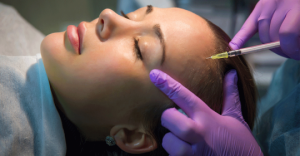
Over the years, the use of Wrinkle reduction treatment has extended, from medicinal to cosmetic. Developed as a biological weapon, numerous studies have revealed its effectiveness and usefulness beyond enhancing your facial features. Right now, Wrinkle reduction treatment has been highly useful in multidisciplinary fields such as urology, endocrinology, ophthalmology, endocrinology and neurology. This neurotoxin provided benefits for many chronic conditions such as muscle spasm and stiffness by relaxing abnormal muscle contractions.
When there are problems concerning muscle activity, Wrinkle reduction treatment has been a go-to drug due to its effect that help release stiffness.
Below are the different conditions using Wrinkle reduction treatment for neurological disorders:
-
- Blepharospasm – a neurological condition manifested by forcible closure of eyelids or abnormal twitching of eyelashes and eyelid. In the case of blepharospasm, the eye muscles contract to the point that the person could not open his eyes and they have to use their hands to open them. Such condition can be an unpleasant experience for the sufferer. A very minimal dose of Wrinkle reduction treatment can be administered through a fine needle in the eyelids.
- Hemifacial Spasm – a condition when there is involuntary muscle contractions of the face on one side, manifested by flickering movement of the affected muscles. The condition can be resolved by injecting Wrinkle reduction treatment on the lower face and around the eye.
- Meige’s Syndrome – a condition in which the upper and lower part of the facial muscle contracts.
- Cervical dystonia – a condition characterized by high muscle tone in the neck, resulting in different positions of the head. Sometimes, the neck rotates and pulls in a certain direction. The condition is sometimes called ‘wry neck’ or torticollis. Wrinkle reduction treatment helps by providing controlled relaxation of the affected muscles.
- Upper and lower limb spasticity – there are times when a person recovers from stroke, muscle stiffness can hinder recovery. In some cases, spasticity is severe that it causes restrictions of movement. Wrinkle reduction treatment help relax the muscles to assist physiotherapy.
- Writer’s Cramp – a condition in which a person have difficulty in writing only. A person with writer’s cramp may only write one to two pages and after that, their hands begins to give up.
- Migraine – not all cases of migraine require Wrinkle reduction treatment injection. Wrinkle reduction treatment can be used for migraine if the person experience frequent headaches and failed to respond with other treatment.
Wrinkle reduction treatment for Neurological Disorders – How It Work
Wrinkle reduction treatment for neurological disorders causes a controlled relaxation with abnormal muscle movements or spasticity. The process is ‘irreversible’ and has to be injected every 3 to 6 months. Wrinkle reduction treatment can be highly effective when injected in the right spot. It is important to hire someone with considerable experience and expertise in Wrinkle reduction treatment injection

